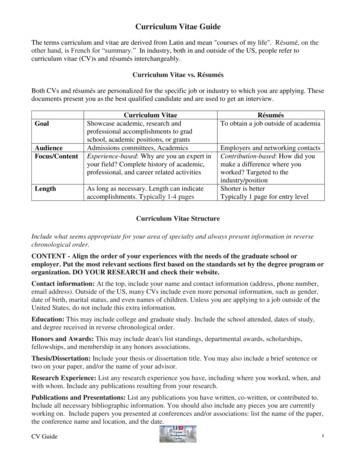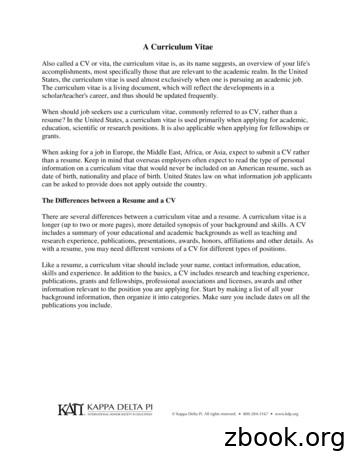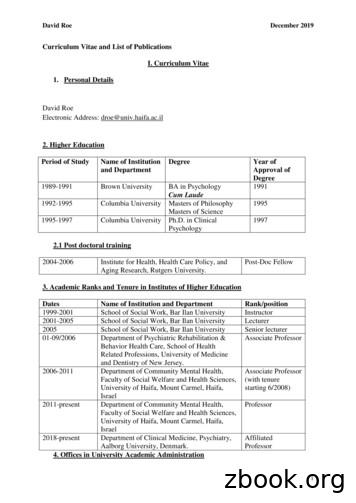Jonathan S. Ostroff: Curriculum Vitae
CV: Jonathan Ostroff (26 January 2010) Page 1Jonathan S. Ostroff: Curriculum VitaeSummaryHistoryPh.D, University of Toronto, Department ofElectrical Engineering, 1987M.A.Sc., University of Toronto,Department of Electrical Engineering,1979B.Sc., University of the Witwatersrand,Johannesburg, Department of ElectricalEngineering, 1976PublicationsBooks:Chapter in books:Refereed journals:Refereed conferences:1617 1 (invited)36 4 (invited)Current Grants: 2005 – 2010: NSERC Discovery Grant, 33,000 (per year for 5 years) 2009: Ontario Research Fund ResearchExcellence (ORF‐RE, Ministry of Research andInnovation). Title: Certification of Safety‐Critical Software‐Intensive Systems. PI: TomMaibaum, McMaster University. 6.9m( 21m including private sector andinstitutional contributions)1991 – 2009: Associate Professor(tenured), Department of ComputerScience and Engineering, YorkUniversity1987 – 1991: Assistant Professor1986 – 1987: Lecturer1979 – 1981: Systems Engineer for processcontrol software, Imperial Oil Ltd., IOCO Research interestsrefinery, B.C. Software engineering1977 – 1977: Computer Hardware Formal methods for specifying, verifying andEngineer, Perseus Computing andcertifying safety critical and object orientedAutomationconcurrent systems Mathematics of program constructionSupervision Mathematical models for user requirements, Currently co‐supervising 1 PhD student system specifications and testing 7 M.Sc students graduated 26 CSE4080 senior projects supervised, Teaching1 NSERC USRA, and 2 summer internsCOSC1020 Intro. to Computer Science I External examiner for 3 PhD theses atCOSC1030 Intro. to Computer Science IIother universitiesCOSC2001 Intro. to Theory of ComputationMATH2090 Intro. to Mathematical LogicProfessional affiliationsCSE3341 Intro. to Program Verification Senior member, IEEECSE3311 Software Design Faculty Fellow, IBM Centre forCSE4351 Real‐Time Systems TheoryAdvanced Studies, IBM TorontoCSE4352 Real‐Time Systems PracticeLaboratory, 2003‐2006CSE4312 Software Engineering RequirementsCSE6411 Programming Logic Complex Systems Observer membership to ECMA TC39‐CSE6442 OO Software ConstructionTG4 technical committee for theELE1643 Special Topics in Control, U of Tstandardization of Eiffel: Analysis,Design and Programming Language
CV: Jonathan Ostroff (26 January 2010) Page 2Personal DetailsJonathan S. OstroffDepartment Of Computer Science and Engineering,York University, 4700 Keele Street, North York Ontario, Canada, M3J 1P3.Email: jonathan@cse.yorku.ca Tel: 416‐736‐2100 X77882 Fax: 416‐736‐5872Research FundingPeriod2005 ‐2010Granting agencyNSERC Discovery GrantTitle: Formal and Agile methods for Model DrivenDevelopmentAmount 33,000 (per year for 5years)2009Ontario Research Fund Research Excellence (ORF‐RE,Ministry of Research and Innovation).Title: Certification of Safety‐Critical Software‐IntensiveSystems. Grant number: RE03 ‐045. PI: Tom Maibaum,McMaster University. York University is a collaboratinguniversity. 6.9m ( 21m includingprivate sector andinstitutionalcontributions)The overall Principal Investigator is Tom Maibaum,McMaster University. McMaster is the lead university andWaterloo and York are collaborating institutions. Inaddition to Prof. Maibaum there are 5 PIs and 14 co‐investigators. I am the PI for York and as such will be onthe Board of Directors. The Board of Directors providesoverall supervision and leadership in setting long‐termpriorities of the project’s activities and ensures thesuccessful operation of the research programme within thefinancial and programmatic guidelines of the grant.According to the proposal, I am slated to work on suchaspects as assessment of engineering methods for criticalsystems, the generic model of the idealised certificationprocess, engineering methods for safety‐critical systemsdevelopment and case studies and specialization of theprocess in the medical, nuclear and financial domains.2003IBM Eclipse Innovation GrantUS 28,000
CV: Jonathan Ostroff (26 January 2010) Page 32001‐2005 Individual NSERC Operating Grant: “Formal methods for 31,000 (per year for 4object‐oriented software construction”.years)2001‐2004 NSERC MFAIF Grant: “Personnel Support for York Centre of 136,000 (per year forVision”. (PI: Michael Jenkin).3 years)1999‐2002 Ontario Research and Development Challenge Fund 228,000 (over(ORDCF). “Improvements to the Centre for Vision Research 3 years)(CVR) at York University”. (PI: Laurence Harris)1999‐2003 Canadian Foundation for Innovation (CFI). “ Active Sensory 2,400,000 over 3Processing in Real and Synthetic Environments”. The total yearsgrant is 5,800,000 including ORDCF matching funds( 2,400,000) and Industry (SGI) & York contribution( 1,000,000). In collab oration with and on behalf of TheCentre for Vision Research at York University. (PI: LaurenceHarris)19972001 Individual NSERC Operating Grant: “Design of Safety 26,000 (year 1)Critical Real‐Time Systems”. 28,600 (year 2) 30,030 (year3 and 4)1993‐1997 Individual NSERC Operating Grant: “Design of Safety 20,000Critical Real‐Time Systems”.per year1993Presidents NSERC: Documenting StateTime 15001992Presidents NSERC. 25001990/93 Individual NSERC Operating Grant: “Design of real‐time dis 22,442crete event systems”.per year1990President’s NSERC. 25001991Individual NSERC Equipment Grant, “High Performance 20,836Color Workstation”.1991/1994 NSERC Infrastructure Grant (one of 7 investigators): 40,000“Research Central Computing Facility”.per year1991NSERC Equipment Grant, “Computer/file‐server upgrades” 76,637(one of 7 investigators).1987/90 Individual NSERC Operating Grant: “Real‐time computer 16,000control of discrete event systems”.per year1989/1991 NSERC Equipment Grant “Research Machine Upgrade” 56,000(one of 6 investigators).1988/91 NSERC Infrastructure Grant “Research micro‐computer 33,000workstation” (one of 4 investigators).per year1989‐91 NSERC Equipment Grant: “Research Machine Upgrade” 56,000(one of 6 investigators).1989President’s NSERC. 30001986/87 President’s NSERC fund. 3000 per yearTeaching Grants
CV: Jonathan Ostroff (26 January 2010) Page 42000‐20011999‐2000York Software Engineering Seed Funding (withRichard Paige)SCOTL teaching development grant 28,080 (2 years) 2500 (1 year)Invited Presentations TAP’07: Tests And Proofs12‐14 February 2007 at ETH Zurich. Keynote SpeakerWorkshop for Software Engineering – Southern Ontario Universities, May 2000.“A Software Engineering Degree at York: How to Do It.” May, 2000 (for a SCOTL grant)Invited panelist for “Tools for Formal Methods”, 3rd IEEE Symposium on Assessment ofQuality Software Development Tools, Washington D.C., June 1994.Invited speaker at REX Workshop on Real‐Time: Theory in Practice'', Holland, June 1991.See [I2] in publications record.European Control Conference, July 1991, Grenoble, France. See [I3] in publication record.Invited speaker, NASA Workshop on Discrete Event Systems and Artificial Intelligence,Princeton, Nov 1990.Two 75 minute lectures presented to NATO Advanced Studies Institute on “TheApplication of Advanced Computing Concepts and Techniques to Control Engineering”,Italy, Sep 1987. See [I1] in publications record.Waterloo, December 1994, University of Ottawa, Nov. 1994, McMaster University,October 1994.Invited speaker in INRS/BNR Series on Formal Methods, University of Quebec, Verdun,May 1994.Department of Computer Science, Carnegie Mellon University, April 1990, Department ofElectrical Engineering, McGill University, November 1989, Department of ComputerScience, Technische Universiteit Eindhoven, The Netherlands, September 1989.Department of Computer Science, Queens University, August 1988. Department ofSystems and Computer Engineering, Carlton University, February 1988.Professional Activities Senior Member, IEEEFaculty Fellow, IBM Centre for Advanced Studies, IBM Toronto Laboratory, 2003‐2006.Observer membership to ECMA TC39‐TG4 technical committee for the standardization ofEiffel: Analysis, Design and Programming Language.PC Member TOOLS'09, PC member for TOOLS’08, PC member for The InternationalConference TOOLS EUROPE 2007 ‐ Objects, Models, Components, Patterns, ETH Zurich,Switzerland on 24‐28 June 2007. PC member for TAP’07
CV: Jonathan Ostroff (26 January 2010) Page 5 Observer membership to European Computer Manufacturers Association ECMA TC39‐TG4technical committee for the standardization of Eiffel: Analysis, Design and ProgrammingLanguage (2004 – 2009). The current standard is ECMA‐367, revision 2, June 2006.External Examiner for PhD thesis, "Making classes provable through contracts, models andframes", Bernd Schoeller, ETH Zurich, (supervisor Bertrand Meyer), January 2008.PC Member for SEFM’07, 5th IEEE International Conference on Software Engineering andFormal Methods London, UK September 10‐14, 2007PC member for CORDIE06 (York UK) and CERTSOFT06 (FM’06, McMaster University).External Examiner for Piotr Nienaltowski, “Practical framework for contract‐basedconcurrent object‐oriented programming”, February 2007, ETH Zurich (supervisiorBertrand Meyer).External Examiner for Raman Ramsin, PhD Thesis, University of York, UK, 3 July 2006(supervisors Fiona.A.C. Polack and Richard Paige).York University merit award 2006‐07.Faculty Fellow, IBM Centre for Advanced Studies, IBM Toronto Laboratory, 2003‐2006.PC member for 3rd IEEE International Conference on Software Engineering and FormalMethods , Koblenz, Germany , September 5‐9, 2005.PC Member 2nd IEEE Intnl. Conference on Software Engineering and Formal Methods,SEFM2004, Beijing September, 2004.PC Member: 2nd Workshop on Quantitative Aspects of Programming Languages QAPL2004, Barcelona, Spain, 27‐28 March 2004 ‐ Satellite Event of ETAPS 2004.Program Committee for Workshop on Software Engineering and Formal Methods,Software Verification Research Centre, The University of Queensland, Brisbane, 2003.Program Committee for Workshop on Education and Training at TOOLS’02 Conference onTrusted Components, Formal Specifications, Eiffel & .NET, Santa Barbara, July 2002.NSF Panel for grants in Software Engineering. January 2000.Member of the Program Committee, 5th Int. AMAST Workshop on Real‐Time andProbabilistic Systems (ARTS'99) in Bamberg, Germany, May 1999.Member of the Program Committee, Fourth AMAST Workshop on Real‐Time Systems,Concurrent, and Distributed Software. Towards a mathematical transformation‐baseddevelopment, Mallorca, May 1997.Member of the Program Committee, The Third AMAST Workshop on Real‐Time Systems;Models, Properties and Control, Salt Lake City, Utah, USA, March 6 ‐ 8, 19961995: Organized the York Workshop on Industrial Strength Theorem Provers, which washeld on the York Campus in the summer of 1995, using the Ariel laboratory for the toolsfair.1990–1997: Member of the Human Performance in Space Laboratory, Institute for Spaceand Terrestrial Science, Toronto.Refereed articles for ACM Transactions on Software Engineering, IEEE Transactions onSoftware Engineering, Kluwer Formal Methods in Systems Design, IEEE Transactions onAutomatic Control, Real‐Time Journal, Mathematics of Control Signals and Systems, IEEETransactions on Parallel and Distributed Systems, Distributed Computing, IEEE Real‐TimeSystems Symposium, Hawaii International Conference on Systems Sciences, IEEE
CV: Jonathan Ostroff (26 January 2010) Page 6Conference on Decision and Control and IEEE Tran. on Software Engineering Systems, ACMTransactions on Software Engineering. Reviewer for NSERC grants proposals, NSERCCollaborative Grant, NSF grant proposals, SEED program (California Institute ofTechnology), and NATO grant proposals. Chaired Session at 9th IEEE Real‐TimeSymposiums, 1988.PublicationsLifetime SummaryBooks:Chapter in books:Papers in refereed journals:Papers in refereed conference proceedings:Student authors are in bold1617 1 (invited)36 4 (invited)
CV: Jonathan Ostroff (26 January 2010) Page 7Book[B1] J.S. Ostroff. Temporal Logic for Real‐Time Systems. Advanced Software DevelopmentSeries (Series Editor: J. Kramer), Research Studies Press (John Wiley & Sons), Taunton,England, 1989.Miscellaneous[M1] J.S. Ostroff. European Journal of Control, Volume 6 issue 6 (2000), Invited discussion ofthe paper by J. Zaytoon., "A Contribution to the Validation of Grafcet Controlled Systems".Chapter in Books[I3] J.S. Ostroff. “Visual Tools for Verifying Real‐Time Systems”. In Theories and Experiences inReal‐ Time Systems, AMAST Series in Computing, Vol. 2. Iowa City: World Scientific Press,1994.[I2]J.S. Ostroff, Synthesizing Reactive Systems, “Real‐Time: Theory in Practice”, LNCS 600,Springer‐ Verlag, 1992.[I1]J.S. Ostroff, Temporal Logic and Extended State Machines in Discrete Event Control in“The application of advanced computing concepts and techniques to control engineering”.NATO ASI Series in Computer and System Sciences, Springer‐Verlag, pages 215‐236, 1988.Reprinted as Chapter in Books[K3] J.S. Ostroff. Deciding Properties of Timed Transition Models. In Chapter 3 of Readings inReal‐Time Systems, Y.H. Lee and C. M. Krishna (eds.), pp184‐197, IEEE Computer SocietyPress, 1993. Reprint of [J3].[K2] J.S. Ostroff. Formal Methods for the Specification and Design of Real‐time safety Criticalsystems. In Chapter 2 of Real‐Time Systems, Abstractions, Languages and DesignMethodologies., K.M. Kavi (ed.), IEEE Computer Society Press Tutorial, 1992. Reprint of[J5].[K1] J.S. Ostroff and W.M. Wonham. A Framework for Real‐time Discrete Event Control. InChapter 2 of Real‐Time Systems, Abstractions, Languages and Design Methodologies, K.M.Kavi (ed.), IEEE Computer Society Press Tutorial, 1992. Reprints of [J2].Refereed or Invited Journal articles[J18] Jonathan S. Ostroff, Faraz Ahmadi Torshizi, Hai Feng Huang, and Bernd Schoeller,"Beyond contracts for concurrency", Formal Aspects of Computing, vol. 21:4, pp. 319‐346,2009. [J17] Piotr Nienaltowski , Bertrand Meyer, and Jonathan S. Ostroff, "Contracts forConcurrency", Formal Aspects of Computing, vol. 21:4, pp. 304‐318, ‐2[J16] Richard F. Paige, Phil J. Brooke, and Jonathan S. Ostroff. “Metamodel‐Based ModelConformance and Multi‐View Consistency Checking”, ACM Transactions on Software
CV: Jonathan Ostroff (26 January 2010) Page 8Engineering and Methodology,Vol. 16:3, pp. 1‐49, 2007.[J15] Jonathan S. Ostroff, Richard F. Paige, David Makalsky and Phillip J. Brooke. E‐Tester: aContract‐Aware and Agent‐Based Unit Testing Framework for Eiffel. Journal of ObjectTechnology, Vol. 4:7, pp. 97‐114, 2005.[J14] Nati Fuks, Jonathan S. Ostroff and Richard Paige. SCOOP to Eiffel Code Generator. Journalof Object Technology, Vol. 3:10, pp. 143‐160, 2004.[J13] R.F. Paige and J.S. Ostroff. ERC: an Object‐Oriented Refinement Calculus for Eiffel, FormalAspects of Computing, Springer‐Verlag, volume 16, pp. 51‐79, 2004.[J12] Richard F. Paige, Jonathan S. Ostroff and Phillip J. Brooke. Theorem Proving Support forView Consistency Checking. L'OBJET: Software, Databases, Networks 9(4): pp. 115‐1342003.[J11] Richard Paige and Jonathan S. Ostroff. The Single Model Principle. Journal of ObjectOriented Technology. Vol 1:5, pp. 63‐81, 2002 (invited contribution).[J10] J.S. Ostroff and R.F. Paige. The Logic of Software Design. IEE Proceedings ‐ SoftwareEngineering 147(3), pp. 73‐80, 2000.[J9] R.F. Paige, J.S. Ostroff, and P.J. Brooke. Principles of Modeling Language design,Information and Software Technology. No 42, pp. 665‐675, 2000.[J8] J.S. Ostroff. Composition and Refinement of Discrete Real‐Time Systems. ACM Trans. onSoftware Engineering Methodology, pages 1‐48, Vol. 8 Number 1, Jan. 1999.[J7] J.S. Ostroff. A Visual Toolset for the Design of Real‐Time Discrete Event Systems. IEEETrans. on Control Systems Technology, pages 320‐327, May 1997.[J6] J.S. Ostroff. A Verifier for Real‐Time Systems. Real‐Time Systems Journal, KluwerAcademic Publishers, Volume 4, pp5–35, Massachusetts, 1992.[J5] J.S. Ostroff. Formal Methods for the Specification and Design of Real‐time safety Criticalsystems. Journal of Systems and Software, Volume 18, No. 1, pp33–60, April 1992.(Reprinted in [K2]).[J4] J.S. Ostroff. Constraint Logic Programming for Reasoning about Discrete Event Processes.The Journal of Logic Programming, Volume 11, Numbers 3 & 4, pp243–270, ElsevierScience Publishing Co., N.Y., 1991.[J3] J.S. Ostroff. Deciding Properties of Timed Transition Models. IEEE Transactions on Paralleland Distributed Systems, Vol. 1, No. 2, pages 170–183, April 1990. (Reprinted in [K3]).[J2] J.S. Ostroff and W.M. Wonham. A Framework for Real‐time Discrete Event Control. IEEETransactions on Automatic Control, Vol. 35, No. 4, pages 386–397, April 1990. (Reprintedin [K1]).[J1] J.S. Ostroff. A Logic for Real‐Time Discrete Event Processes. IEEE Control SystemsMagazine, Vol. 10, No. 4, pages 95–102, June 1990.
CV: Jonathan Ostroff (26 January 2010) Page 9Refereed or Invited Conference and Workshop Proceedings[C40] Faraz Torshizi, Jonathan S. Ostroff, Richard F. Paige and Marsha Chechik, "The SCOOPconcurrency model in Java‐like languages", Communicating Process Architectures 2009(CPA2009 at Formal Methods Week 2009), Technische Universiteit Eindhoven, (to appear,November 2009).[C39] Jonathan Ostroff & Faraz Ahmadi Torshizi, “Testable Requirements and Specifications”,Invited Paper, Tests and Proofs 2007 (TAP 2007) , LNCS 4454, pp. 17‐40, 2007.[C38] Jonathan S. Ostroff, Chen‐Wei Wang, Eric Kerfoot, and Faraz Ahmadi Torshizi,"Automated Model‐based Verification of Object‐Oriented Code", Workshop on VerifiedSoftware: Theory, Tools, and Experiments 2006 (VSTTE 2006, part of FLoC 2006), MicrosoftReport MSR‐TR‐2006‐117, pp. 1‐12, 2006.[C37] Jonathan S. Ostroff, Chen‐Wei Wang, Faraz Ahmadi Torshizi, and Eric Kerfoot, "ES‐Verify:A Tool for Automated Model‐based Verification of Object‐Oriented Code", FormalMethods 2006 Posters & Research Tools (FM'06), McMaster University, Canada, August2006.[C36] Jonathan S. Ostroff, Faraz Torshizi and Hai Feng Huang, "Verifying Properties BeyondContracts of SCOOP Programs", International Symposium on Concurrency, Real‐Time andDistribution in Eiffel‐like Languages (CORDIE'06), York UK Report YCS 405, pp4‐25, 2006.[C35] Richard Paige, Phillip J. Brooke, Jonathan S. Ostroff. Specification Driven Development ofan Executable Metamodel in Eiffel. Workshop WS5 on Software Model Engineering(WiSME'04, 7th International Conference on the UML), Lisbon, Portugal, 2004. (This is alonger version of the extended abstract in ISSRE'04 below.)[C34] Richard F. Paige, Jonathan S. Ostroff and Phillip J. Brooke. Agile Development of aMetamodel in Eiffel. Supplementary Proceedings of the 15th IEEE InternationalSymposium on Software Reliability Engineering (ISSRE 2004), Saint‐Malo, Bretagne,France, November 2004.[C33] Jonathan S. Ostroff, David Makalsky and Richard Paige. Agile Specification DrivenDevelopment. Fifth International Conference on Extreme Programming and AgileProcesses in Software Engineering XP2004, LNCS 3092, pp. 104‐112, Springer‐Verlag,Garmisch‐Partenkirchen, Germany, June, 2004.[C32] Richard Paige and Jonathan S. Ostroff, "Specification‐Driven Design with Eiffel and Agentsfor Teaching Lightweight Formal Methods", Proc. CologNet Conference on TeachingFormal Methods, LNCS 3294, pp107‐123, Springer Verlag 2004.[C31] Ali Taleghani and Jonathan S. Ostroff. The BON Development Tool. Proc. EclipseTechnology eXchange eTX/OOPSLA'03, pp. 10‐14, ACM, Anaheim CA, 2003.[C30] R.F. Paige, J.S. Ostroff, and P.J. Brooke. A Test‐Based Agile Approach to Checking theConsistency of Class and Collaboration Diagrams. Proc. UK Software Testing Workshop,University of York, 4‐5 September 2003.[C29] R.F. Paige, J.S. Ostroff, and P.J. Brooke. Formalising Eiffel Reference and Expanded Types
CV: Jonathan Ostroff (26 January 2010) Page 10in PVS, Proc. International Workshop on Aliasing, Confinement, and Ownership in Object‐Oriented Programming (IWACO), c
McMaster University. York University is a collaborating university. The overall Principal Investigator is Tom Maibaum, McMaster University. McMaster is the lead university and Waterloo and York are collaborating institutions. In addition t
Curriculum Vitae Guide The terms curriculum and vitae are derived from Latin and mean "courses of my life". Résumé, on the other hand, is French for “summary.” In industry, both in and outside of the US, people refer to curriculum vitae (CV)s and résumés interchangeably. Curriculum Vitae vs. Résumés
CV curriculum vitae CV v. resume – Length – Scholarly/scientific. Curriculum Vitae CV curriculum vitae CV v. resume – Length – Scholarly/scientific – Detailed. Curriculum Vitae (CV) Name, title, curren
A Curriculum Vitae Also called a CV or vita, the curriculum vitae is, as its name suggests, an overview of your life's accomplishments, most specifically those that are relevant to the academic realm. In the United States, the curriculum vitae is used
wrath of King Saul. As David hid in a field, Jonathan went to the festival with his father, the king, and watched for signs of Saul's hatred toward David. Jonathan at first couldn't believe that his father wanted to harm David. When Jonathan discovered how fervently Saul wished for David's death, Jonathan was so troubled that he couldn .
3.0 TYPES OF CURRICULUM There are many types of curriculum design, but here we will discuss only the few. Types or patterns are being followed in educational institutions. 1. Subject Centred curriculum 2. Teacher centred curriculum 3. Learner centred curriculum 4. Activity/Experience curriculum 5. Integrated curriculum 6. Core curriculum 7.
1 Curriculum Vitae and List of Publications I. Curriculum Vitae 1. Personal Details David Roe Electronic Address: droe@univ.haifa.ac.il 2. Higher Education Year of Approval of Degree Name of Institution Degree and Department Period of Study BA in Psychology 1991 Cum Laude 1989-1991 Brown University Masters of Philosophy 1995 Masters of Science
Vita vs. Vitae (pronounced VEE-tye, not VEE-tay) The correct term for the CV is the “curriculum vitae” Latin meaning “[the] course of [my] life” “vitae”is plural for the word “vita” but in the case of curriculum vitae, itis a modifier for the singu
America’s criminal justice system. Racial and ethnic disparity foster public mistrust of the criminal jus-tice system and this impedes our ability to promote public safety. Many people working within the criminal justice system are acutely aware of the problem of racial disparity and would like to counteract it. The pur-pose of this manual is to present information on the causes of disparity .























